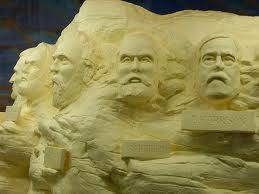|
| |
Butter arts or sculpture
Main
Article page |
Beauty articles
|
Health page |
Computers|
Diseases |
Education |
Entertainment |
Family
Business |Fitness|
Fruits and Vegetables
|
Jobs |
General |
Personality|
Technology
|
Tourism |
Sports
Biography Page|
Heroes & Incredible peoples
|
Inventions
|
Useful Tips
| Stories
Arts |
Butter
sculpture |
Sand sculpture |
Vegetable carving |
Shadow arts

Butter sculptures often depict animals, people, buildings and other objects.
They are best known as attractions at state fairs, but can also be found
on banquet tables and even small decorative butter pats.The earliest documented
butter sculptures date from 1536 Europe where they were used on banquet tables.
Butter sculptures are still a popular attraction at agricultural fairs, banquet
tables and as decorative butter patties.
The history of carving food into sculptured objects is ancient. Archaeologists
have found bread and pudding molds of animal and human shapes at sites from
Babylon to Roman Britain.Butter sculpture is an ancient Tibetan Buddhist
tradition; yak butter and dye are still used to create temporary symbols for the
Tibetan New Year and other religious celebrations.
The earliest butter sculpture in the modern sense (as public art and not a
banquet centerpiece) can be traced to the 1876 Centennial Exhibition where
Caroline Shawk Brooks, a farm woman from Helena, Arkansas, displayed her
Dreaming Iolanthe, a basrelief bust of a woman modeled in butter. It was kept
cold with a system of layered bowls and frequent ice changes. Brooks had no
formal art training but as a farmer she spent years making butter and since
1867, to make the work more interesting, she began sculpting it, eventually
using it as a selling point. As her skills progressed she began to see it as
more than marketing butter, indeed as an art form unto itself. In 1873 she made
her masterpiece Dreaming Iolanthe, which she would re-do over the years at
regional exhibitions around the US.Thus she was invited to bring a replica to
the Centennial Exhibition in 1876 where it drew so much attention and praise she
was invited to sculpt live for the crowds.Afterwards she studied in Paris and
Florence and eventually became a professional sculptor who worked in marble, but
occasionally made more butter art.
The heyday of butter sculpting was from about 1890 to 1930. During this
period refrigeration became widely available, and the American dairy industry
began promoting butter sculpture as a way to compete against synthetic butter
substitute like Oleomargarine (margarine).
| |
|



